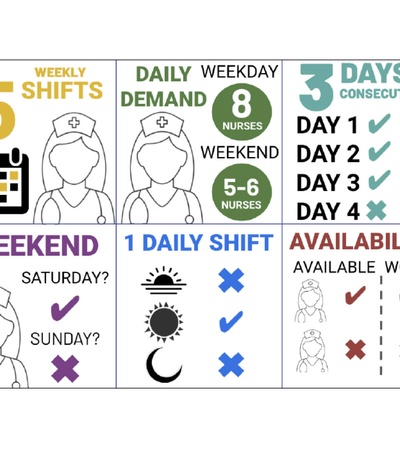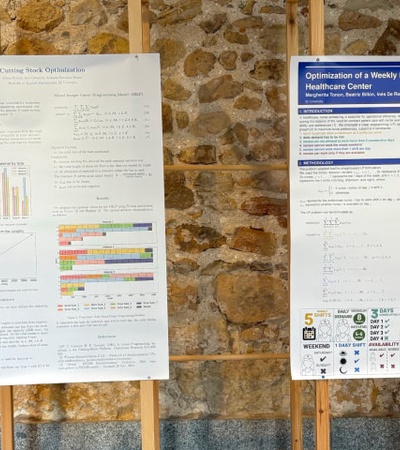
Optimization of a Weekly Nurse Schedule in a Healthcare Center.
Introduction
Introduction
In healthcare, nurse scheduling is essential for operational efficiency, requiring the balance of the need for constant patient care with nurse availability and preferences [1]. We employed a linear programming (LP) approach [2] to maximize nurse preferences, subject to 6 constraints:
Methodology
Methodology
The problem adapted itself to straightoward LP formulation.
We used the binary decision variable xijk. i = 1, . . . , 36 represents the 36 nurses, j = 1, . . . , 7 represents the 7 days of the week, and k = 1, 2, 3 represents the 3 shifts (morning, afternoon, and night), where:
pijk represents the preference nurse i has to work shift k on day j, and aij represents whether nurse i is available on day j.
The LP problem can be formulated as:
Results
Results
After modeling the LP problem in Python using the LP library Pyomo [3], and using data given from the client about the preferences pijk and availabilities aij for each nurse, we created a Gantt chart [4].
- Nurses can identify their weekly schedule by finding their Nurse ID on the y-axis and checking which shifts they are working on the x-axis.
- The model selected 159 shifts in total 144 correspond to the nurses’ highest preferences, 15 correspond to the second highest preferences, and 0 correspond to the third preferences.
CONCLUSIONS
CONCLUSIONS
We successfully maximized nurse shift preferences with respect to scheduling constraints using an LP approach.
Some key considerations were not taken into account. For example:
- Schedule flexibility: holidays, sick days, emergencies are not taken into account. The schedule assumes constant nurse availability.
- Shift quantity imbalance: Nurses work different numbers of shifts, causing resentment if all nurses get paid equally.
The model could be improved by adding a constraint stating every nurse must work the same number of shifts.
The hospital could implement a pay-per-shift system to promote fairness.
REFERENCES
REFERENCES
[1] Jaumard, Brigitte, et al. “A Generalized Linear Programming Model for Nurse Scheduling.” European Journal of Operational Research, vol. 107, no. 1, 13 Jan. 2011, pp. 1–18.
[2] Bertsimas, Dimitris, and John Tsitsiklis. Introduction to Linear Optimization. 1st ed., Athena Scientific, 1997.
[3] “HiGHS — Pyomo 6.6.2 Documentation.” Readthedocs.io, 2023, pyomo.readthedocs.io/en/6.6.2/library_reference/appsi/appsi.solvers.highs.html. Accessed 26 Nov. 2024.
[4] Waskom, Michael. “Seaborn.Heatmap.” Seaborn, seaborn.pydata.org/generated/seaborn.heatmap.html. Accessed 04 Oct. 2024.
This project was presented as a poster as part of the Bachelor in Applied Mathematics, within the courses Optimization 1 and Communication Skills. It showcases students' ability to apply optimization techniques and effectively communicate their findings.





